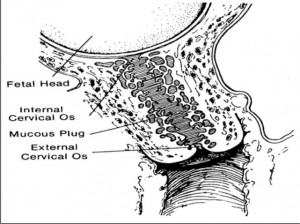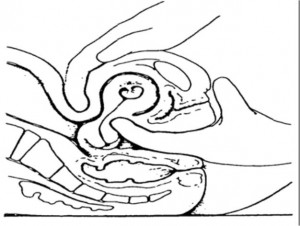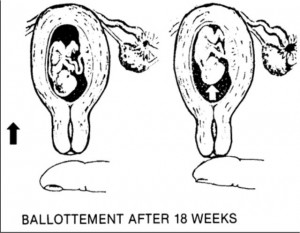Probable signs of pregnancy are those signs commonly noted by the physician upon examination of the patient.
These signs include uterine changes, abdominal changes, cervical changes, basal body temperature, positive pregnancy test by physician, and fetal palpation.
a. Uterine Changes.
(1) Position. By the twelfth week, the uterus rises above the symphysis pubis and it should reach the xiphoid process by the 36th week of pregnancy. These guidelines are fairly accurate only as long as pregnancy is normal and there are no twins, tumors, or excessive amniotic fluid.
(2) Size. The uterine increases in width and length approximately five times its normal size. Its weight increases from 50 grams to 1,000 grams.
(3) Hegar’s sign. This is softening of the lower uterine segment just above the cervix. When the uterine is compressed between examining fingers, the wall feels tissue paper thin. The physician will use bimanual maneuver simultaneously (abdominal and vaginal) and will cause the uterus to tilt forward (see figure 3-1). The Hegar’s sign is noted by the sixth to eighth week of pregnancy.
(4) Ballottement. This is demonstrated during the bimanual exam at the 16th to 20th week. Ballottement is when the lower uterine segment or the cervix is tapped by the examiner’s finger and left there, the fetus floats upward, then sinks back and a gentle tap is felt on the finger (see figure 3-2). This is not considered diagnostic because it can be elicited in the presence of ascites or ovarian cysts.
b. Abdominal Changes. This corresponds to changes that occur in the uterus, as the uterus grows the abdomen gets larger. Abdominal enlargement alone is not a sign of pregnancy. Enlargement may be due to uterine or ovarian tumors, or edema. Striae gravidarum may also be classified as a probable sign of pregnancy by the physician.
c. Cervical Changes.
(1) Goodell’s sign. The cervix is normally firm like the cartilage at the end of the nose. The Goodell’s sign is when there is marked softening of the cervix. This is present at 6 weeks of pregnancy.
(2) Formation of a mucous plug. This is due to hyperplasia of the cervical glands as a result of increased hormones. It serves to seal the cervix of the pregnant uterus and to protect it from contamination by bacteria in the vagina (see figure 3-3). The mucous is expelled at the end of pregnancy near or at the onset of labor.

(3) Braxton-Hick’s contractions. This involves painless uterine contractions occurring throughout pregnancy. It usually begins about the 12th week of pregnancy and becomes progressively stronger. These contractions will, generally, cease with walking or other forms of exercise. The Braxton-Hick’s contractions are distinct from contractions of true labor by the fact that they do not cause the cervix to dilate and can usually be stopped by walking.
d. Basal Body Temperature. This is a good indication if the patient has been recording for several cycles previously. A persistent temperature elevation spanning over 3 weeks since ovulation is noted. Basal body temperature (BBT) is 97 percent accurate.
e. Positive Pregnancy Test by the Physician. This may be misread by doing it too early or too late. Even if the test is positive, it could be the result of ectopic pregnancy or a hydatidiform mole (an abnormal growth of a fertilized ovum) (see figure 3-4).
f. Fetal Palpation. This is a probable sign in early pregnancy. The physician can palpate the abdomen and identify fetal parts. It is not always accurate, a mass in the abdomen may be palpated and mistakenly identified as an infant.



